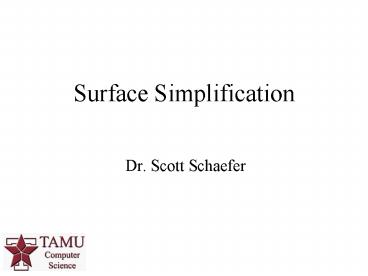Dr. Scott Schaefer - PowerPoint PPT Presentation
Title:
Dr. Scott Schaefer
Description:
Surface Simplification Dr. Scott Schaefer * */32 Surface Simplification Given a closed polygon model, reduce the number of polygons and maintain appearance of the ... – PowerPoint PPT presentation
Number of Views:63
Avg rating:3.0/5.0
Title: Dr. Scott Schaefer
1
Surface Simplification
- Dr. Scott Schaefer
2
Surface Simplification
- Given a closed polygon model, reduce the number
of polygons and maintain appearance of the shape
5804 tris
2500 tris
1000 tris
500 tris
3
Reducing Polygons
- Perform local, topological operations to reduce
number of polygons - Vertex removal
4
Reducing Polygons
- Perform local, topological operations to reduce
number of polygons - Vertex removal
- Edge Collapse
5
Reducing Polygons
- Perform local, topological operations to reduce
number of polygons - Vertex removal
- Edge Collapse
- Face Collapse,
6
Reducing Polygons
- Perform local, topological operations to reduce
number of polygons - Vertex removal
- Edge Collapse
- Face Collapse,
7
Surface Simplification
- How do we determine the order of edge collapse
operations? - Where do we place new vertex after collapse?
8
Error Metrics For Simplification
- QEF Quadratic Error Function
- Measures distance to infinite planes
9
Error Metrics For Simplification
- QEF Quadratic Error Function
- Measures distance to infinite planes
10
Error Metrics For Simplification
- QEF Quadratic Error Function
- Measures distance to infinite planes
symmetric 3x3
3x1
1x1
11
Error Metrics For Simplification
- QEF Quadratic Error Function
- Measures distance to infinite planes
symmetric 3x3
3x1
1x1
Requires 10 floats independent of number of
polygons!!!
12
Combining QEFS
13
Combining QEFS
Add 10 numbers to combine QEFs!!!
14
Placement of Vertices Using QEFs
- Place new vertex at minimum of error function
15
Placement of Vertices Using QEFs
- Place new vertex at minimum of error function
16
Placement of Vertices Using QEFs
- Place new vertex at minimum of error function
17
Placement of Vertices Using QEFs
- Place new vertex at minimum of error function
Not invertible in flat areas or straight edges!!!
18
Placement of Vertices Using QEFs
- Place new vertex at minimum of error function
Pseudoinverse minimizes v
19
Placement of Vertices Using QEFs
- Let where c is a point we want to
minimize the distance to
20
Placement of Vertices Using QEFs
- Let where c is a point we want to
minimize the distance to
21
Placement of Vertices Using QEFs
- Let where c is a point we want to
minimize the distance to
22
Placement of Vertices Using QEFs
- Let where c is a point we want to
minimize the distance to
23
Plane-Based Quadratic Error Function
- Compact representation (10 numbers)
- Fast to combine multiple functions (addition)
- Relatively easy to minimize (pseudoinverse)
- Suffers from numerical instabilities
24
Surface Simplification Algorithm
- Build QEFs for each vertex
- For each edge
- Compute combined QEF and error
- Insert edge into priority queue sorted by error
- While poly gt target
- Collapse edge
25
Surface Simplification Edge Collapse
- Place new vertex at minimizer of QEF
26
Surface Simplification Edge Collapse
- Place new vertex at minimizer of QEF
- QEF of new vertex is combined QEF
27
Surface Simplification Edge Collapse
- Place new vertex at minimizer of QEF
- QEF of new vertex is combined QEF
- Remove all edges touching collapsed edge from
priority queue
28
Surface Simplification Edge Collapse
- Place new vertex at minimizer of QEF
- QEF of new vertex is combined QEF
- Remove all edges touching collapsed edge from
priority queue - Recompute QEF/error for all edges touching new
vertex and insert into priority queue
29
Surface Simplification Edge Collapse
- Edge collapse may alter topology of surface
- Test for topology change and exclude unsafe edge
collapses - Unsafe edge may become safe after another
collapse - Alternatively, perform two edge collapses
30
Surface Simplification Edge Collapse
- Edge collapse may alter topology of surface
- Test for topology change and exclude unsafe edge
collapses - Unsafe edge may become safe after another
collapse - Alternatively, perform two edge collapses
unsafe edge collapses
31
Surface Simplification Edge Collapse
- Edge collapse may alter topology of surface
- Test for topology change and exclude unsafe edge
collapses - Unsafe edge may become safe after another
collapse - Alternatively, perform two edge collapses
32
Surface Simplification
- Extremely fast
- Somewhat memory intensive
- Limits maximum surface size
- Greedy algorithm
- Does not guarantee optimal sequence of edge
collapses!!!































